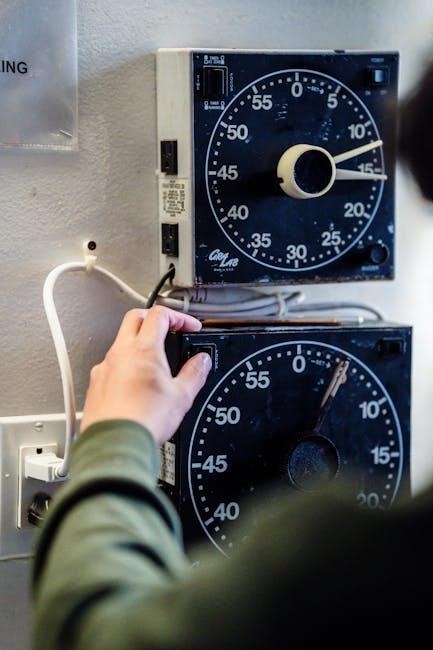
The Ranco thermostat is a user-friendly device designed for precise temperature control in various applications. Known for its digital display and keypad programming, it offers ease of use and reliability.
With compatibility across multiple languages, including English, Spanish, French, and Portuguese, it caters to a broad audience. Its installation is straightforward, requiring minimal setup and no complex positioning.

Installation
Installation requires turning off power at the main source. Mount the thermostat carefully to avoid twisting the control body, which may affect calibration.
Ensure the control body is securely fastened and proper capillary routing is maintained for optimal performance.
2.1 Location Selection
Selecting the right location for your Ranco thermostat is crucial for accurate temperature control. Choose a spot that allows proper air circulation and avoids direct sunlight or drafts.
The location should permit easy access for programming and maintenance. Ensure the area is free from moisture and extreme temperatures to prevent calibration issues.
For remote bulb sensing, mount the bulb securely against the surface being monitored. Use compatible clamps or wells to ensure accurate temperature readings.
2.2 Mounting the Thermostat
Mounting the Ranco thermostat requires careful attention to ensure proper functionality. Begin by turning off the power supply to avoid electrical shock hazards during installation.
Use the provided mounting bracket to secure the thermostat to the wall or surface. Ensure the screws used do not extend beyond the bracket to prevent damage to the control body;
Avoid twisting or straining the control body, as this may shift its calibration. If a remote bulb is used, mount it securely against the surface being sensed using compatible clamps or wells.
Follow the installation manual’s guidelines to ensure the thermostat is level and firmly attached. Proper mounting is essential for accurate temperature sensing and reliable operation.
2.3 Wiring Requirements
Proper wiring is essential for the Ranco thermostat to function accurately. Ensure the power supply is turned off before connecting any wires to avoid electrical shock hazards.
Refer to the wiring diagram provided in the manual to connect the thermostat correctly to your heating or cooling system. Use the appropriate wire gauge for your setup, ensuring all connections are secure and not loose.
For remote bulb sensing, connect the bulb wires to the designated terminals on the thermostat. Ensure the remote bulb is properly mounted and compatible with the control body for accurate temperature readings.
Double-check all connections before restoring power. Improper wiring can lead to malfunctions or safety issues. If unsure, consult a licensed electrician or the installation manual for guidance.
2.4 Handling the Control Body
Handling the Ranco thermostat’s control body requires care to maintain its calibration and functionality. Avoid twisting or straining the control body, as this may shift its calibration and affect performance.
Mount the control body securely, ensuring the screws used do not extend through the mounting bracket and touch the control body itself. This prevents damage and ensures accurate temperature sensing.
For models requiring remote bulb sensing, ensure the bulb is properly clamped or placed in a bulb well compatible with the control body. This ensures accurate temperature readings and reliable operation.
Always follow the manufacturer’s guidelines for handling and mounting to preserve the thermostat’s precision and longevity. Improper handling can void the warranty or lead to premature wear.
2.5 Remote Bulb Sensing
Remote bulb sensing allows the Ranco thermostat to accurately measure temperatures in specific locations, enhancing control precision. This feature is particularly useful for applications requiring monitoring of remote areas or specific surfaces.
To ensure proper function, the remote bulb must be securely mounted against the surface being sensed. Use compatible bulb clamps or wells to avoid misalignment or damage to the bulb.
When routing the capillary tubing, avoid twisting or kinking, as this can interfere with temperature sensing. Proper installation ensures accurate readings and reliable thermostat performance.
Always follow the manufacturer’s guidelines for remote bulb placement and handling to maintain calibration and ensure optimal system operation.

Features
The Ranco thermostat offers advanced features including a digital display, keypad programming, and differential temperature control, ensuring precise and customizable temperature management for various applications.
3.1 Digital Display
The Ranco thermostat features a clear and intuitive digital display, providing real-time temperature readings and operational status. This display allows users to easily monitor and adjust settings, ensuring optimal temperature control. The digital interface is designed for readability, with large, easy-to-view numbers and symbols. It supports multiple languages, making it accessible to a wide range of users. The display also shows error codes and maintenance alerts, helping users identify and address issues promptly. Additionally, the digital display is energy-efficient, minimizing power consumption while maintaining functionality. This feature enhances user experience by offering a seamless and efficient way to manage temperature settings, making it a key component of the Ranco thermostat’s user-friendly design.
3.2 Keypad Programming
The Ranco thermostat’s keypad programming offers a user-friendly interface for setting temperature preferences and operational modes. With a simple keypad, users can easily program schedules, setpoints, and differential temperature controls. The keypad provides clear feedback through LED indicators and audible tones, ensuring settings are accurately applied. It supports multiple language options, including English, Spanish, French, and Portuguese, enhancing accessibility. The programming process is intuitive, requiring minimal technical knowledge. Additionally, the keypad is designed for durability, with long-lasting buttons that withstand frequent use. Detailed instructions for programming are provided in the comprehensive user manual. This feature simplifies temperature management, allowing users to customize their environment efficiently. The keypad’s responsiveness and clear interface make it a standout feature of the Ranco thermostat.
3.3 Differential Temperature Control
The Ranco thermostat features differential temperature control, which allows for precise temperature regulation by monitoring the difference between the setpoint and actual temperature. This function ensures the system operates efficiently, preventing unnecessary cycling of the heating or cooling units. By maintaining a consistent temperature differential, the thermostat enhances overall system performance and stability.
In cooling mode, the differential is typically set to 2°F, but it can be adjusted based on specific requirements. This feature is particularly useful in applications where maintaining tight temperature control is crucial. The differential temperature control minimizes oscillations, reducing wear on the system and optimizing energy usage. It is a key component of the Ranco thermostat’s advanced temperature management capabilities, ensuring reliable and efficient operation across various environments.

Operating Modes
The Ranco thermostat operates in cooling and heating modes, with specific differentials for each. Cooling mode typically uses a 2°F differential, while heating mode adjusts accordingly for efficiency.
4.1 Cooling Mode
In cooling mode, the Ranco thermostat activates the cooling system when the temperature rises above the setpoint. It uses a differential setting to determine when to cycle the compressor and fan, ensuring efficient cooling without excessive operation. The default cooling differential is typically 2°F, but this can be adjusted based on specific requirements. Proper installation and calibration are crucial to maintain accurate temperature control. The thermostat’s digital display provides real-time feedback, allowing users to monitor and adjust settings easily. Remote bulb sensing can also be utilized for precise temperature measurement in remote locations. Regular maintenance, such as cleaning the thermostat and checking wiring connections, ensures optimal performance in cooling mode. Always refer to the user manual for specific instructions on configuring and operating the cooling mode effectively.
4.2 Heating Mode
In heating mode, the Ranco thermostat engages the heating system when the ambient temperature drops below the setpoint. This mode ensures consistent warmth by cycling the heating elements according to the configured differential. The default heating differential is typically 2°F, but adjustments can be made to suit specific comfort preferences. Proper installation and calibration are essential for accurate temperature control. The thermostat’s digital display allows users to monitor and adjust settings seamlessly. Remote bulb sensing can also be employed for precise temperature measurement in remote areas. Regular maintenance, such as cleaning the thermostat and verifying wiring connections, is recommended to maintain optimal performance. The thermostat’s compatibility with various heating systems makes it a versatile solution for different applications. Always consult the user manual for detailed instructions on configuring and operating the heating mode effectively.
4.3 Differences Between Modes
The Ranco thermostat operates in distinct modes, each tailored for specific climate control needs. In cooling mode, the system activates when the temperature rises above the setpoint, engaging the compressor and fan to lower the temperature. Conversely, heating mode initiates when the temperature drops below the setpoint, activating heating elements or furnaces to warm the space. The differential temperature control varies slightly between modes, with cooling typically set to a 3°F differential and heating to a 2°F differential. This ensures precise control and energy efficiency. Remote bulb sensing can also influence mode operation, providing accurate temperature readings. Understanding these differences is crucial for optimizing comfort and system performance. Proper configuration of each mode, as outlined in the manual, ensures reliable operation and maintains desired conditions effectively.

Maintenance
Regular maintenance ensures optimal performance. Clean the thermostat with a soft cloth, avoiding harsh chemicals. Recalibrate annually for accuracy. Ensure no moisture exposure to prevent damage.
5.1 Cleaning the Thermostat
Cleaning the Ranco thermostat is essential for maintaining its functionality. Use a soft, dry cloth to gently wipe the exterior and display. Avoid using harsh chemicals or abrasive materials, as they may damage the screen or controls. For tougher stains, a slightly damp cloth can be used, but ensure the device is powered off beforehand. Never spray liquids directly onto the thermostat, as moisture can seep inside and cause electrical issues. Regular cleaning prevents dust buildup, which can interfere with temperature sensing and keypad responsiveness. Additionally, check the remote bulb for dirt or debris, as this can affect temperature readings. Proper maintenance ensures accurate operation and extends the lifespan of the thermostat.
5.2 Calibration Procedures
Calibrating the Ranco thermostat ensures accurate temperature control. Start by turning off power to the device. Locate the calibration adjustment, typically a small trimmer potentiometer. Using a screwdriver, gently adjust the potentiometer until the display matches the actual temperature. For precise calibration, compare the thermostat’s reading with a reliable thermometer. If using a remote bulb, ensure it is securely mounted and not exposed to direct heat sources. Avoid using harsh chemicals or abrasive materials, as they may damage the sensor. After calibration, restore power and test the thermostat’s response. Proper calibration ensures optimal performance and prevents temperature-related issues. Regular checks and adjustments are recommended to maintain accuracy, especially in environments with fluctuating conditions. Always refer to the manual for specific calibration steps tailored to your Ranco thermostat model.

Troubleshooting
Troubleshooting the Ranco thermostat involves identifying common issues like inaccurate temperature readings or unresponsive controls. Check power supply, ensure proper calibration, and verify wiring connections for optimal functionality.
6.1 Common Issues
Common issues with the Ranco thermostat include inaccurate temperature readings, unresponsive controls, and system malfunctions. These problems often arise from wiring errors, incorrect calibration, or sensor damage. Ensure the thermostat is properly powered and all connections are secure. If issues persist, refer to the error codes provided in the manual for specific guidance. Regular maintenance, such as cleaning and recalibrating, can prevent many of these problems. Always follow the manufacturer’s troubleshooting steps to resolve issues effectively and maintain optimal performance. Addressing these common issues promptly helps ensure reliable temperature control and extends the lifespan of the thermostat.
6.2 Understanding Error Codes
Ranco thermostats display error codes to identify specific issues, ensuring quick troubleshooting. Codes like E1 or E2 typically indicate sensor malfunctions or communication errors. Refer to the manual for code meanings, as they vary by model. For example, E3 might signal a power supply problem, while E4 could indicate a faulty relay. These codes guide users to the root cause, whether it’s a wiring issue, sensor failure, or system malfunction. By addressing the code’s underlying issue, users can restore proper functionality. Always consult the troubleshooting section of the manual for detailed solutions. Understanding these codes empowers users to resolve problems efficiently, minimizing downtime and ensuring optimal performance. Regular maintenance and proper installation can help prevent many of these errors, keeping the thermostat operating smoothly.

Technical Specifications
- Temperature Range: -40°F to 212°F (-40°C to 100°C)
- Compatibility: Works with heating, cooling, and dual systems
- Power Requirements: 12V or 24V AC/DC
- Sensor Types: NTC thermistor or capillary bulb
7.1 Temperature Range
The Ranco thermostat operates within a wide temperature range of -40°F to 212°F (-40°C to 100°C), making it suitable for various applications, including refrigeration and heating systems.
This range ensures precise temperature control in extreme conditions, maintaining accuracy and reliability. The thermostat is designed to handle both low-temperature environments, such as cold storage, and high-temperature settings like industrial processes;
Its versatility allows it to adapt to different systems, ensuring optimal performance across diverse temperature demands. The thermostat’s durability and robust design enable it to withstand these temperature extremes without compromising functionality.
Whether for cooling or heating applications, the Ranco thermostat delivers consistent results, making it a reliable choice for both residential and commercial use.
7.2 Compatibility
The Ranco thermostat is designed to be compatible with a wide range of heating, cooling, and refrigeration systems, making it a versatile choice for various applications.
It works seamlessly with both single-stage and multi-stage systems, ensuring efficient temperature control in residential and commercial environments. The thermostat is also compatible with multiple languages, including English, Spanish, French, and Portuguese, catering to a diverse user base.
Its universal design allows it to integrate with different types of HVAC systems, providing flexibility and ease of installation. Whether for industrial or household use, the Ranco thermostat adapts to meet specific needs, ensuring optimal performance and reliability.
7.3 Power Requirements
The Ranco thermostat typically operates on a 12V or 24V power supply, ensuring compatibility with most HVAC systems. It is essential to ensure the power source matches the thermostat’s specifications to avoid damage or malfunction.
Before installation, always turn off the power at the main electrical source to prevent electrical shock hazards. The thermostat requires a stable power supply to maintain accurate temperature control and proper functionality of its digital display and keypad.
Incorrect wiring or voltage supply can lead to operational issues, so it is crucial to follow the installation manual carefully. The Ranco thermostat is designed to be energy-efficient, consuming minimal power while providing precise temperature regulation.
7.4 Sensor Types
The Ranco thermostat utilizes high-precision sensors to ensure accurate temperature measurement. It typically employs NTC (Negative Temperature Coefficient) sensors, known for their reliability and responsiveness to temperature changes.
For remote bulb sensing, the thermostat can be equipped with a bulb clamp or well, ensuring precise monitoring of the desired location. These sensors are compatible with capillary tubes, allowing for flexible installation in various applications.
The sensors are designed to provide consistent and accurate readings, which are crucial for the thermostat’s ability to regulate temperature effectively. Proper installation and handling of the sensors are essential to maintain their calibration and performance.

Safety Precautions
Always disconnect power before installation to avoid electrical shock. Ensure proper handling of sensors and avoid exposing them to water or extreme conditions for optimal performance and safety.
8.1 Electrical Safety
Ensure the power supply is turned off at the main source before starting any installation or maintenance to prevent electrical shock.
Avoid overloading circuits and use appropriate wiring as specified in the manual. Never restore power until all connections are secure and verified.
Keep the thermostat away from water sources to prevent short circuits. Regularly inspect wires for damage and replace them if necessary.
Do not touch electrical components with wet hands or while standing on a conductive surface. Always follow safety guidelines to ensure safe operation and longevity of the device.

User Manual Details
The Ranco thermostat user manual is a comprehensive guide designed to assist users in understanding and operating the device effectively. It covers installation, maintenance, and troubleshooting procedures in detail.
The manual is available in multiple languages, including English, Spanish, French, and Portuguese, ensuring accessibility for a diverse user base. It includes clear diagrams and step-by-step instructions for various operational modes.
Key sections of the manual include wiring diagrams, temperature control settings, and safety precautions. It also provides information on compatible systems and technical specifications for optimal performance;
- Installation guidelines
- Maintenance schedules
- Troubleshooting tips
The manual emphasizes the importance of adhering to safety protocols to avoid electrical hazards; It is recommended to read the manual thoroughly before using the thermostat to ensure safe and efficient operation.

Manufacturer Support
Ranco provides comprehensive support for their thermostat products, ensuring customer satisfaction and ease of use. The manufacturer offers detailed user manuals, technical specifications, and troubleshooting guides to assist users.
Customer support is accessible through various channels, including email, phone, and online resources. Ranco also provides warranty information and dedicated customer service teams to address any queries or issues promptly.
Additional support materials, such as FAQs and video tutorials, are available on the official website. This ensures that users can resolve common issues independently and make the most of their thermostat’s features.
- Detailed user manuals in multiple languages
- Technical support via phone and email
- Online resources and FAQs
- Warranty information
Ranco’s commitment to quality and customer care ensures that users receive the assistance they need to maintain and operate their thermostats effectively.




